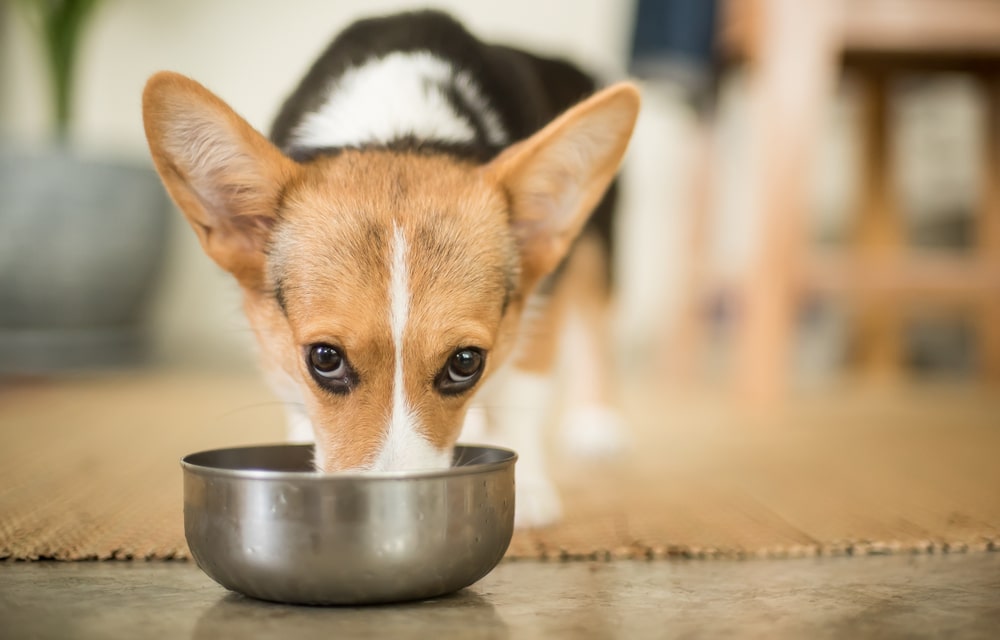Feeding Corgis: The Most Important Things for Beginner Owners.
Welsh Corgi Pembroke is one of the most well-known companion dog breeds. Their charming appearance and friendly nature have long captivated many dog enthusiasts around the world. Thanks to their compact size, these pets can be kept not only in a country house but also in apartment conditions. They do not require complicated care, but like all pets, they need balanced nutrition and a proper feeding regimen. In our article, we will tell you what to feed Corgis at different ages and what breed-specific considerations to take into account when choosing their diet.
What to feed Corgis: puppies and adult dogs?
You can use either commercial pet food or homemade meals. Both options are acceptable but have some nuances and should not be mixed together.
Commercial pet food.
The main advantage of commercial pet food is its convenience. It is divided into two types:
- Dry food. Granules (also known as kibbles) encourage chewing of solid food. Consuming this type of diet provides mechanical teeth cleaning, which helps prevent the formation of plaque and tartar.
- Wet food. Pouches with meat chunks in jelly or sauce, and canned pâtés, differ from kibbles in having a higher moisture content. Regular consumption of wet food helps maintain hydration and minimizes the likelihood of bladder stone formation.
These types of commercial diets can be combined with each other. The main thing is to stick to a single brand.
Dog food cannot be replaced with cat food, as the composition and calorie content of these diets differ significantly.
Another important advantage of dry food and wet canned food is their wide range. The variety of product lines allows you to choose a product that takes into account the age, breed, activity level, and other individual characteristics of your pet, including its health.
Homemade food is meals prepared from regular ingredients.
The advantage is that the owner has control over the purchase of ingredients and the cooking process. However, there are many disadvantages:
- The need for daily cooking;
- The difficulty of achieving a balance of nutrients;
- High risk of contamination and poisoning when preparing or storing food improperly.
When choosing homemade food, it is necessary to consult a veterinary dietitian. Only they can create a balanced and safe menu that prevents the development of vitamin deficiencies and other disorders.
Transitioning from one type to another.
Once a chosen diet is selected, it should be followed throughout the pet’s life. However, in case of health problems or if the pet categorically refuses the current type of food, an exception can be made. The transition should be gradual and non-traumatic. Usually, it takes about 1 week to complete the transition. The previous food is gradually replaced with the new one, gradually increasing the amount of the new food each time.
Abruptly transitioning to a new type of feeding can lead to stress and gastrointestinal disturbances.
What breed-specific characteristics should be considered?
Welsh Corgis are not picky eaters and prone to overeating. With unrestricted access to food and a diet that is excessively high in calories, they can quickly gain weight. In the long term, obesity can have a negative impact on their joints and spine, leading to the development of dysplasia and intervertebral disc problems.
Puppies are at risk and should have a smooth and gradual development. Sudden imbalances and weight jumps are not allowed.
Prohibited foods in a Corgi’s diet.
Not everything that is common for humans is safe for dogs. The list of prohibited foods includes:
- Garlic, onions, and sorrel;
- Mushrooms and legumes;
- Berries and fruits with pits;
- Citrus fruits, raisins, and grapes;
- Small and tubular bones;
- Spices and smoked products;
- Fatty and raw meat;
- Pearl barley, buckwheat, and semolina;
- Pastry, pasta, and confectionery products.
The listed products contribute to the development of anemia, flatulence, allergies, and acute intoxication. Too sharp fragments can also cause injuries.
It is also better to avoid consuming milk. In animals, as well as in some people, lactose intolerance may develop during growth, which can lead to constant bloating, diarrhea, and nausea.
When choosing commercial pet food, it is advisable to avoid those sold in bulk. Such storage is accompanied by the settling of dust and the presence of dangerous bacteria.
What to feed Welsh Corgis – recommendations by age.
The food should be chosen according to the age and current weight of the Corgi. The younger the pet, the more calorie-dense the food it needs.
Feeding a puppy.
The juvenile body undergoes rapid growth and has an exceptionally fast metabolism. Everything consumed goes towards the development of internal organs and the musculoskeletal system. Therefore, if the feeding guidelines are followed, puppies rarely gain excess weight and may even have a slight leanness, which is considered normal.
Another important characteristic of puppies is their teeth. During the weaning period, their teeth are just starting to grow, so it is important to choose a softer consistency of food for them. This task is well accomplished by the Starter diet, which can be softened to a porridge-like consistency.

From 2 months of age, puppies are transitioned to larger and denser kibbles to teach them to chew more solid food. Puppy formulas, such as Puppy food, are typically used for this purpose. They are commonly fed from 2 months of age until adulthood (for Corgis, this is until 10-12 months).
Feeding Adolescents.
Adolescents include sexually mature puppies. They already resemble adult dogs much more and have all their permanent teeth. The final dental formation occurs at 6-7 months.
Metabolic processes in adolescents are also very fast. At this stage of development, the muscular framework is formed. Despite the dog’s adult appearance, it is too early to switch them to an adult diet. Pay attention to the descriptions on the manufacturer’s packaging: they provide recommendations for the duration of using puppy products.
Feeding adult dogs.
Welsh Corgi Pembroke dogs are on the border between two size categories: miniature (up to 10 kg) and medium (10 to 25 kg). Dogs of this breed reach adulthood at 10-12 months, when their nutritional needs change. From this age, Corgis are transitioned to a less calorie-dense food labeled as Adult, designed for adult dogs.
Feeding a pregnant and lactating bitch.
A diet change is necessary during pregnancy and lactation. Developing the fetus and producing milk requires an enormous amount of energy. All the consumed food is immediately burned, and the basic food requirements increase by 3-4 times.
If you simply increase the usual portion, the dog will not be able to eat it. As the puppies grow, the space for food in her stomach significantly decreases. The only option left is to switch to a more calorie-dense diet that allows satisfying hunger with a small volume of food. The Starter Mother & Babydog line is suitable for this purpose. It can be fed until lactation is ceased.
Feeding elderly pets.
Elderly animals are less active, and they may experience age-related changes in their bodies. They benefit from diets with moderate calorie content and increased amounts of plant fibers and cellulose. Such diets contain higher levels of antioxidants and chondroprotective agents to slow down age-related changes. The transition to this diet is typically made around 7-8 years of age.
Do you need to give vitamin supplements?
Commercial pet foods are formulated to meet all the nutritional needs of dogs. Their composition is already balanced and does not require additional supplements. Taking vitamins is only necessary when using homemade food.
Uncontrolled consumption of vitamins and mineral supplements is not permissible. Suitable preparations and their proper usage should be determined strictly by a veterinary doctor.
How many times a day to feed a corgi?
The next important point is the feeding schedule. Food is not left freely available but is given strictly at specific times, based on the pet’s age.
Puppy.
A puppy’s small stomach is not capable of digesting a large amount of food at once. To prevent indigestion, Welsh Corgis are fed frequently but in small portions until they reach 1 year of age.
- Less than 2 months – 6-8 times a day with night feedings.
- 2-3 months – 5-6 times a day.
- 3-6 months – 3-4 times a day.
- 6-12 months – 3 times a day.
The daily dose is divided into equal portions.
An adult dog
After 1 year, Welsh Corgis are switched to a two-meal diet. Food is given after physical activity, i.e. after active games and walks.
Exceptions are allowed during pregnancy, lactation, and illnesses. In all these cases, the dog is switched to fractional feeding, reducing the load on the digestive organs.
Weight control
To prevent health problems, Welsh Corgis’ weight must be monitored. During the first 4 weeks of life, weighing should be done daily, and after 1 month – once a week. Kitchen and floor scales are suitable for measurement. In the second case, a puppy or an adult corgi can be weighed directly in your arms. The main thing is not to forget to subtract your own weight from the obtained value.
Weight gain can also be tracked by external signs. Healthy dogs should have easily palpable ribs. If it is difficult to find them under a layer of fat or, on the contrary, they are too visible, the current diet needs to be changed urgently. Consult a veterinarian – they will help develop the most effective weight loss program.
Food restriction is not always justified, and sometimes it can be dangerous. Sometimes it is enough to simply increase current activity. Welsh Corgis love running the most, so be sure to take your pet for long walks in the park and play ball with him.
Drinking regime
The last point worth attention is the drinking regime. It includes controlling the volume and quality of liquid consumed throughout the day. The drinking norm also depends on age. On average, it is 100 ml per 1 kg of weight, but the younger the pet, the more liquid it needs.
Some of the water enters the body with food. With regular consumption of wet canned food, a dog may drink less. If only dry kibble is present in the diet, the volume of liquid consumed should be twice the amount of food eaten.
Water is left freely available, unlike food. Before serving it, it is mandatory to filter out harmful impurities. An alternative option is to use already purified bottled water.
The water bowl quickly becomes dirty. In the summer, it should be changed at least twice a day, and during the rest of the year – once a day. If you forget to clean the old water in a timely manner or simply don’t want to do it, consider purchasing a special drinking fountain. The filter in it prevents the liquid from stagnating and increases its usability.
Conclusion.
Proper feeding of Welsh Corgis is an important part of preventing common breed-related diseases. A balanced diet and avoiding overfeeding will help prevent vitamin deficiencies and weight gain, ensuring the proper development of the dog at all stages of life.
Найкращі практики догляду за хвостиками у 2025.
⚠️ We suggest that you read all the opinions on our portal and take note of them at your own discretion. Do not self-medicate! In our articles we collect the latest scientific data and opinions of authoritative experts in the field of health care. But remember: only a doctor can diagnose and treat.
The portal is intended for users over 13 years old. Some materials may not be suitable for children under the age of 16. We do not collect personal data from children under 13 without parental consent.We have a small request. We strive to create quality content about pet care, and we make it available for free to everyone because we believe everyone deserves accurate and useful information.
Advertising revenue only covers a small portion of our costs, and we want to continue to provide content without having to increase advertising. If you have found our content useful, please support us. It only takes a minute, but your support will help us reduce our reliance on advertising and create even more useful articles. Thank you!


